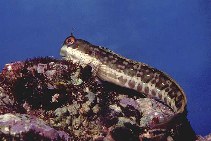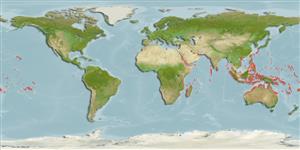http://www.fishbase.org/Summary/speciesSummary.php?genusname=Blenniella&speciesname=periophthalmus ---> http://192.134.151.83/Summary/speciesSummary.php?genusname=Blenniella&speciesname=periophthalmus
http://192.134.151.83/Summary/speciesSummary.php?genusname=Blenniella&speciesname=periophthalmus ---> https://fishbase.mnhn.fr/Summary/speciesSummary.php?genusname=Blenniella&speciesname=periophthalmus
https://fishbase.mnhn.fr/Summary/speciesSummary.php?genusname=Blenniella&speciesname=periophthalmus ---> https://fishbase.mnhn.fr/summary/Blenniella-periophthalmus.html
Blenniella periophthalmus, Blue-dashed rockskipper

You can
sponsor
this page
Common name (e.g. trout)
Genus + Species (e.g. Gadus morhua)
-

-
About this page
-
Languages
-
User feedbacks
-
Citation
-
Uploads
-
Related species
-


 Blue-dashed rockskipper
Add your observation in
Fish Watcher
Upload your
photos
and
videos
Blue-dashed rockskipper
Add your observation in
Fish Watcher
Upload your
photos
and
videos
Pictures
|
Google image
 Blenniella periophthalmus
Blenniella periophthalmus
Picture by
Field, R.
Teleostei (teleosts) >
Blenniiformes
(Blennies) >
Blenniidae
(Combtooth blennies) > Salariinae
Etymology:
Blenniella:
Diminutive of blennius, Greek,blenios = mucus (Ref.
45335
)
.
More on author:
Valenciennes
.
Environment: milieu / climate zone / depth range / distribution range
Ecology
Marine; reef-associated; depth range 0 - 3 m (Ref.
30874
). Tropical; 30°N - 30°S
Indo-Pacific: Red Sea south to Durban, South Africa, east to the Marquesas and Tuamoto Islands, north to the Ryukyu Islands; throughout Micronesia.
Size / Weight / Age
Maturity: L
m
?
range ? - ? cm
Max length : 15.0 cm SL male/unsexed; (Ref.
9710
)
Dorsal
spines
(total): 12 - 14;
Dorsal
soft rays
(total): 18-21;
Anal
spines
: 2;
Anal
soft rays
: 19 - 21;
Vertebrae
: 25 - 27. Diagnosis: Dorsal fin XIII, 18-21, notched between spinous and segmented-ray portions; anal fin II, 19-21; pectoral rays 13-15 (usually 14); pelvic fin I, 3; caudal fin, procurrent rays 7, segmented rays 13. Vertebrae 12 + 25-27. Orbital cirrus simple and slender, may have a short lateral branch, less often up to 4 branches; nasal cirri short and palmate, may rarely have more than 6 branches; nuchal cirri simple and slender, may have a single branch or a ragged edge. Mandibular pores 6. Dorsal lips margin entire, ventral margin crenulated. Occipital crest absent, but large males have a low thin ridge (less than 1.8 mm); no crest or ridge in females Three color-pattern types described for different localities (see Ref. 9962). Body of males with 6-7 dusky bands with 1 or a pair of dark margined, pale, oblong spots on each band; dark spots on spinous dorsal, dusky lines on rayed dorsal. Females with spots on caudal peduncle; body sometimes with fine dark specks (Ref.
4404
). Body depth at anal-fin origin 4.6-5.3 in SL (Ref.
90102
).
Adults inhabit exposed outer intertidal reef flats, where it can hide in cracks and holes. Commonly observed clinging to rocks as the water recedes below them during the low cycle of the swell and this species is often confused with mudskipper gobies (Ref.
48636
). They feed on filamentous algae and associated small invertebrates, such as foraminiferans, ostracods, copepods, and gastropods. Oviparous. Eggs are demersal and adhesive (Ref.
205
), and are attached to the substrate via a filamentous, adhesive pad or pedestal (Ref.
94114
). Larvae are planktonic, often found in shallow, coastal waters (Ref.
94114
). Rarely used for aquarium fish.
Life cycle and mating behavior
Maturity
|
Reproduction
|
Spawning
|
Eggs
|
Fecundity
|
Larvae
Distinct pairing (Ref.
205
).
Springer, V.G. and J.T. Williams
, 1994. The Indo-West Pacific blenniid fish genus
Istiblennius
reappraised: a revision of
Istiblennius
,
Blenniella
, and
Paralticus
, new genus. Smithson. Contrib. Zool. 565:1-193. (Ref.
9962
)
IUCN Red List Status (Ref.
130435
)
Least Concern (LC)
; Date assessed:
24 March 2009
CITES
Not Evaluated
Not Evaluated
Threat to humans
Harmless
Human uses
Fisheries: of no interest
FAO - Publication:
search
|
FishSource
|
More information
Countries
FAO areas
Ecosystems
Occurrences
Introductions
Stocks
Ecology
Diet
Food items
Food consumption
Ration
Common names
Synonyms
Metabolism
Predators
Ecotoxicology
Reproduction
Maturity
Spawning
Spawning aggregation
Fecundity
Eggs
Egg development
Age/Size
Growth
Length-weight
Length-length
Length-frequencies
Morphometrics
Morphology
Larvae
Larval dynamics
Recruitment
Abundance
BRUVS
References
Aquaculture
Aquaculture profile
Strains
Genetics
Electrophoreses
Heritability
Diseases
Processing
Nutrients
Mass conversion
Collaborators
Pictures
Stamps, Coins Misc.
Sounds
Ciguatera
Speed
Swim. type
Gill area
Otoliths
Brains
Vision
Tools
Bio-Quiz
|
E-book
|
Field guide
|
Length-frequency wizard
|
Life-history tool
|
Point map
|
Classification Tree
|
Catch-MSY
|
Special reports
Check for Aquarium maintenance
|
Check for Species Fact Sheets
|
Check for Aquaculture Fact Sheets
Download XML
Summary page
|
Point data
|
Common names
|
Photos
Internet sources
AFORO (otoliths) |
Aquatic Commons
|
BHL
|
Cloffa
|
BOLDSystems
|
Websites from users
|
Check FishWatcher
|
CISTI
|
Catalog of Fishes
:
genus
,
species
|
DiscoverLife
|
ECOTOX
| FAO - Publication:
search
|
Faunafri
| Fishipedia |
Fishtrace
| GenBank:
genome
,
nucleotide
|
GloBI
|
Google Books
|
Google Scholar
|
Google
| IGFA World Record |
MitoFish
|
National databases
|
Otolith Atlas of Taiwan Fishes
|
PubMed
|
Reef Life Survey
| Socotra Atlas |
Tree of Life
| Wikipedia:
Go
,
Search
| World Records Freshwater Fishing |
Zoological Record
Estimates based on models
Preferred temperature (Ref.
123201
): 25 - 29.3, mean 28.4 °C (based on 2554 cells).
Phylogenetic diversity index (Ref.
82804
): PD
50
= 0.5020 [Uniqueness, from 0.5 = low to 2.0 = high].
Bayesian length-weight: a=0.00741 (0.00335 - 0.01640), b=3.02 (2.83 - 3.21), in cm total length, based on LWR estimates for this (Sub)family-body shape (Ref.
93245
).
Trophic level (Ref.
69278
): 3.3 ±0.43 se; based on food items.
Resilience (Ref.
120179
): Medium, minimum population doubling time 1.4 - 4.4 years (Preliminary K or Fecundity.).
Fishing Vulnerability (Ref.
59153
): Low vulnerability (10 of 100).
Nutrients (Ref.
124155
): Calcium = 115 [56, 183] mg/100g; Iron = 0.664 [0.377, 1.120] mg/100g; Protein = 18.5 [17.3, 19.6] %; Omega3 = 0.0767 [, ] g/100g; Selenium = 16.1 [7.5, 34.7] μg/100g; VitaminA = 144 [44, 446] μg/100g; Zinc = 1.83 [1.21, 2.64] mg/100g (wet weight);
Back to Search
Random Species
Back to Top
Accessed through:
Not available
FishBase mirror site :
localhost
Page last modified by :
mrius-barile
- 20 July 2016
Fatal error
: Uncaught ArgumentCountError: Too few arguments to function checkEcotox(), 1 passed in /var/www/html/summary/speciessummary.php on line 2304 and exactly 3 expected in /var/www/html/includes/speciessummary.lib.php:2579 Stack trace: #0 /var/www/html/summary/speciessummary.php(2304): checkEcotox() #1 {main} thrown in
/var/www/html/includes/speciessummary.lib.php
on line
2579
|






